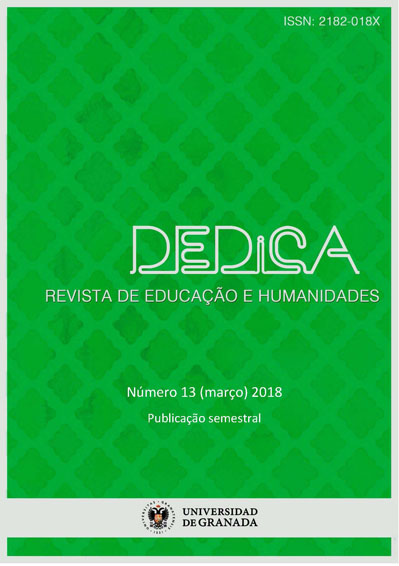Las potencialidades del canto colectivo en el marco del emergente movimiento coral en Mallorca
DOI:
https://doi.org/10.30827/dreh.v0i13.7242Palabras clave:
canto colectivo, transversalidad, interdisciplinariedad, MallorcaResumen
Existen muchas referencias en cuanto a los beneficios que aporta la práctica del canto colectivo, más allá de las estrictamente musicales. En dicha práctica confluyen multitud de elementos que la convierten en un potente elemento de vertebración y cohesión social. Destacan, en esta vertiente, el fomento del trabajo grupal y cooperativo, el desarrollo socio-afectivo o la construcción de la propia identidad dentro del grupo. En un ámbito más individual, el canto colectivo influye también en la autoestima personal, la autoconfianza, el desarrollo cognitivo, el gusto por la estética y cultura, el aprendizaje de las lenguas, etc. A esta lista de elementos transversales a la propia práctica musical, algunos incluso vinculados a disciplinas muy alejadas a la vertiente artística, cabe añadir el componente lúdico y de placer o bienestar personal, tan presente en ensayos y conciertos. En el marco del emergente movimiento coral que se vive en Mallorca, formado eminentemente por agrupaciones de carácter amateur e integradas por cantantes aficionados y en muchos casos con escasos o nulos conocimientos musicales, nuestro estudio analiza la percepción que manifiestan estos cantantes respecto a su práctica.
Descargas
Citas
Alvarado, Y.; Sánchez, A. (2012). Efectividad de la música clásica como recurso didáctico para el fomento de aprendizajes significativos en la asignatura matemática. (Tesis doctoral). Venezuela: Universidad Nacional Experimental Francisco de Miranda.
Barceló, B. (1995). Las funciones del canto. Revista Música y Educación, 24, 37-48.
Cámara, A. (2003). El canto colectivo en la escuela: una vía para la socialización y el bienestar personal. Revista de Psicodidáctica, 15-16, 105-110.
Casal de la Fuente, L. (2015). El canto y la canción en las prácticas educativas de la Pedagogía Científica montessoriana. Mondo Montessori – Maria Montessori nel XXI secolo, 4, 195-203.
Clift, S.; Hancox, G. (2001). The perceived benefits of singing findings from preliminary surveys of a university college choral society. The Journal of the Royal Society for the Promotion of Health, 121, 248-256.
Company Florit, J.; Estelrich Massutí, P. & Moll i Marquès, J. (1985). Tres músics mallorquins: Antoni Torrandell, Joan Maria Thomàs i Antoni Matheu. Artistes de les Balears 1. Palma: Conselleria d’Educació i Cultura del Govern Balear.
Company Florit, J. (1997). Cinquanta anys de la Capella Oratoriana. Una aproximació històrica al Cant Coral de Mallorca. Capella Oratoriana, 50 anys de Música Coral (1947-1997). Palma: Capella Oratoriana.
Cristóbal, R.; Villanueva, J. (2015). La música, un instrumento en la enseñanza del español como lengua extranjera mediante la aplicación de las nuevas tecnologías. Porta Linguarum. Revista Internacional de didáctica de las lenguas extranjeras, 23, 139-151.
Esteve Vaquer, J. J. (2007). La música a les Balears en el segle XIX. Quaderns d’història contemporània de les Balears, núm. 56. Palma de Mallorca: Documenta Balear, 46-49.
Eyre, L. (2011). Therapeutic Chorale for Persons with Chronic Mental Illness: A Descriptive Survey of Participant Experiences. Journal of Music Therapy, 48 (2), 149-168.
Ferrer, R. (2009). El canto coral y las orquestas infantiles, una educación en valores. Eufonía: Didáctica de la Música, 45, 30-38.
Fonseca, M. C.; Toscano-Fuentes, C. (2012). La música como herramienta facilitadora del aprendizaje del inglés como lengua extranjera. Teoría de la Educación, Revista interuniversitaria, 24, 197-213.
Fucci Amatyo, R. (2007). O canto coral como prática sócio-cultural e educativo-musica. Opus, Goiânia, 13 (1), 75-96.
Gackle, L.; Fung, C. (2009). Bringing the East to West: a case study in teaching chinese choral music to a youth choir in the United States. Bulletin of the council for Researh in Music Education, 182, 65-77.
Gelabert Gual, Ll. (2012). Dues iniciatives en l’àmbit no formal de l’ensenyament musical a Mallorca (1977-1995). Educació i Història: Revista d’Història de l’Educació, 20, 141-160.
Gelabert, Ll.; Miranda J. (2012). Baltasar Bibiloni, un pedagogo musical. Revista Música y Educación, 92, 36-49.
Muhip, A.; Gorseu, S. (2014). Psychological and physiological effects of singing in a choir. Psychology of Music, 42, 420-429.
Orobitg Rodríguez, L. (2012). Els Cors de Clavé. Quadern de les idees, les arts i les lletres, 186, 53-54.
Ortiz Molina, Mª. A. (2011). Tendiendo puentes hacia la interculturalidad… desde Andalucía (España) (I). DEDICA. Revista de Educação e Humanidades, 1, 69-94.
Pérez-Aldeguer, S. (2014). Los efectos del canto coral sobre el bienestar psicológico de los alumnos. Revista Argentina de Clínica Psicológica, 23, 199-208.
Pons Pons, D. (1998). Ideologia i cultura a la Mallorca d’entre els dos segles (1986-2005). Palma: Lleonard Muntaner Editor.
Sichivitsa, V. (2003). College choir members' motivation to persist in music: Application of the Tinto model. Journal of Research in Music Education, 51 (4), 330-341.












